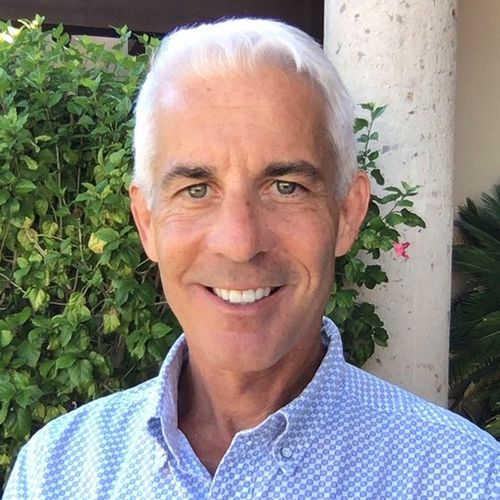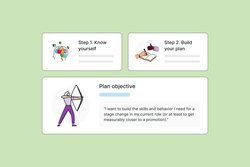
Adopting a new perspective on career development

Written by

VP of People Science at Culture Amp
Building a career development plan may be the most important thing you need for your organization and employees. Why? Because humans have a fundamental need to grow and feel accomplishment. This is especially true for work life. Contrary to popular belief that people leave an organization because of a bad manager, Our People Scientists have found that poor career development opportunities are the most significant contributor to turnover.
Historically, organizational strategies to build career development plans have organized jobs as a hierarchy: stepping stones to move linearly up the corporate ladder. This article will discuss why that approach may no longer be viable and how high-performing organizations adapt their strategies to meet the rapidly changing world of work.
What is the new normal “world of work”?
The traditional idea of static career pathways may no longer hold in the new world of work, where jobs and roles need to be agile and responsive to a dynamic environment. Today, companies are restructuring into teams with fewer levels; jobs are formed more spontaneously around the needs and skills of a customer or project, and technology is rapidly eliminating and adding jobs to the workplace. Let’s go over how the workplace has evolved recently.
Organizations are becoming flatter
One study by Mercer found that more than half of the board of directors surveyed took action to create flatter organizations with more lateral movement and temporary team structures. With fewer hierarchical steps, the notion of linear upward mobility is becoming obsolete.
Jobs and associated skills are in a constant state of change
Whether you call it a Fourth Industrial Revolution or Globalization 4.0, new skills are needed faster than organizations can train for using traditional learning and development within job roles. Given these rapid changes, the skills required for a specific job today may be irrelevant to that job in the future. Thus, building elaborate job matrices with defined competencies and responsibilities may cause more confusion and frustration to employees who attempt to build a career to match the next step.
Jobs are disappearing and emerging
Beyond shifts in skill requirements, the types of jobs available yesterday, today, and tomorrow are changing more rapidly than ever before. Automation has led to the elimination of many physical jobs. It is estimated that 30% of the hours worked globally could be automated by 2030. On the other hand, new jobs are emerging in the space where technology and social interactions merge (e.g., health care, data analytics). Further, the COVID-19 pandemic created many jobs and restructuring that would have never been considered prior. This means that career planning with present-day roles and responsibilities may not reflect what is available and needed tomorrow.
Alternative dynamic career development models
High-performing companies are adapting to the rapidly changing world of work by shifting from static roles and linear career progressions to a model that focuses on an individualized plan to develop evolving skills that can be applied to multiple possible opportunities.
In a recent article, Mikael Bäckström, one of the HR VPs at Spotify, challenged organizations to “rethink” traditional career frameworks and paths. Employees shouldn’t “check the box” of skills required for the next role and expect advancement without regard to business needs or availability for that role. Instead, he established the “Spotify Growth Incubator,” where employees and managers workshop how to grow new, more in-depth skills to meet the organization’s future requirements.
Many top-performing organizations like Cisco, Nestle, Google, IBM, GE, Procter & Gamble, General Mills, Unilever, and Bank of America have implemented “Talent Marketplaces.” It facilitates a more agile work structure where employees can move around in various teams and multiple projects according to their ability to contribute, given their skills. To maximize this approach’s benefits is to break down work into smaller projects and components (e.g., fractionalize).
Vicki Walia, chief talent and capability office at Prudential Financial, found that building a marketplace that seeks skilled experts to take on the specific work components instead of a particular role can result in more efficient and effective ways to get the work done.
Further, organizations like AT&T are developing internal L&D programs focusing on skill development. Their Workforce 2020 program focuses on learning interchangeable skills and offers a new career profile tool that supports career development trajectories for workers who can acquire relevant skills to match future job requirements.
Additionally, micro-learning classes are emerging that facilitate learning focused on listening and providing feedback skills. These competencies are critical to working with others in an organization – regardless of level or role. These become increasingly important as a person moves into a managerial position where coaching, motivating, and directing others require interpersonal skills and awareness.
A better career development plan requires more meaningful conversations
With the growing awareness that relevant skill acquisition is critical to career development and organizational success in this new era of rapid workplace change, the next important consideration is determining how best to develop employees’ skills. Clearly, building a list of skills and job matrices and then leaving employees to navigate the options themselves hasn’t and will continue not to work. Nor will an approach where a manager dictates the development path for an employee. Instead, skill and career development are the responsibility of both the employee and the manager: it must be a collaborative effort.
With this collaboration in mind, we define effective management as inspiring, motivating, and supporting direct reports to do their best work and demonstrating deep personal care and connection with employees. Of course, managers should do this while also consistently achieving desired business outcomes. Effective managers help to build mutually beneficial career objectives reflective of a company’s purpose and values and the employee’s purpose and values. To build these objectives on purpose and values, a manager needs to have regular, ongoing, high-value career 1-on-1 conversations with each employee.
Consider this three-step conversation process
-
Take time to get to know direct reports personally
Ask them to tell their story of their journey from childhood to today. What were some of their difficult life and work choices, including how and why they made them? What lessons did their experiences teach them? You should know what motivates them and what holds them back. -
Explore possibilities
Ask probing questions about what career(s) would be aspirational. It can and perhaps should be more than one. What is their vision when they reach the pinnacle of their career? -
Help them shape a plan
With the future vision in mind, collaborate on a plan to get them there. The goal should focus on which skills the individual wants to grow and how you can help them make it happen. Think of it as the roadmap to self-actualization.
Of course, not all managers can effectively engage in these conversations. Feedback and listening skills can be honed through practice and online micro-learning courses like Skills Coach. Further, online tools like Culture Amp’s 1-on-1 Conversations help managers and employees have more meaningful, continuous conversations about career and individual development goals.
As we mentioned, employees don’t leave their jobs due to a lousy manager alone; however, they leave their jobs when managers don’t do the heavy lifting of helping them build their careers.

Make development a daily practice
In closing, keep it open
With these significant changes in the world of work, your organizations and your people need to focus on growth and drive individualized development to stay current. We need to stop thinking in our old ways of building rigid career frameworks and suggesting that employees follow a linear pathway that will most likely become outdated before the employees get there. Instead, you are responsible for enabling your direct reports to learn relevant skills and ensure ongoing conversations about progression and performance. It’s essential to gauge what employees aim for and how they track to get there.
Finally, given the importance of career development, it is critical to evaluate the degree to which employees believe they are advancing and receiving impactful coaching from their leaders. By conducting regular engagement surveys, you can determine how well your approach to development and coaching is working and where you can focus on improvement.



